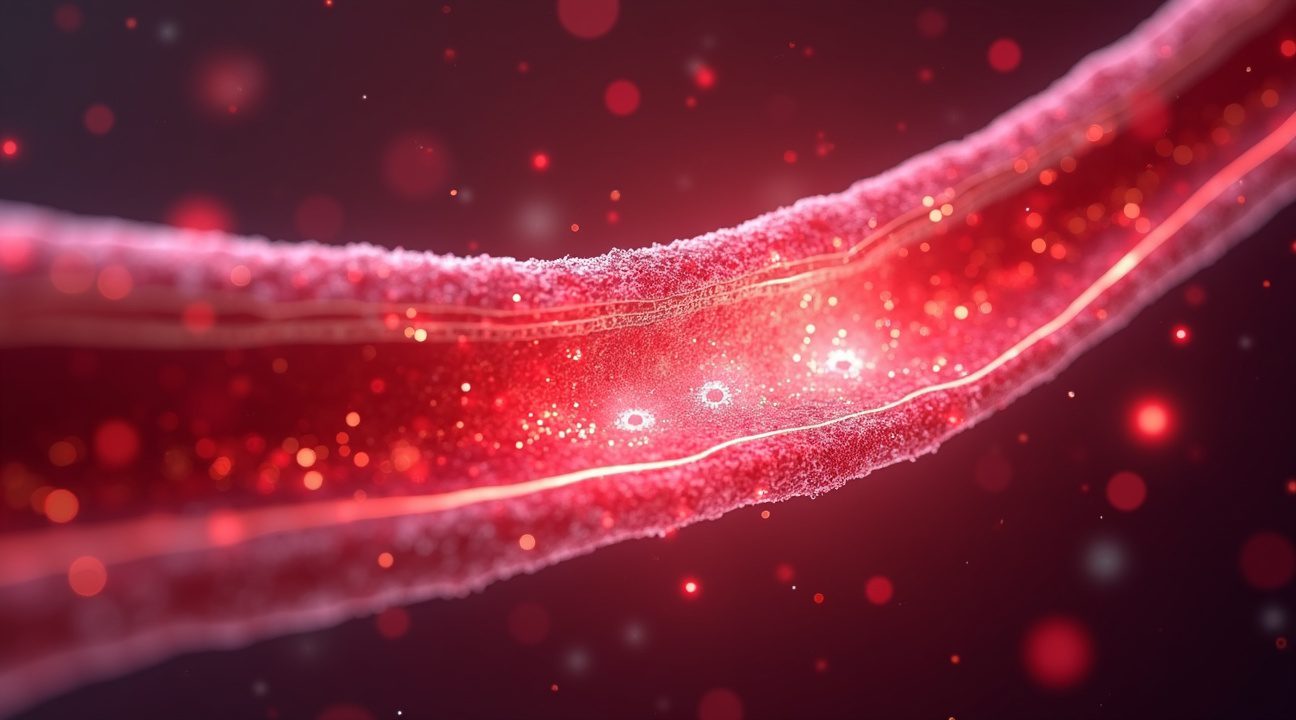Recent research involving patients with coronary artery disease has shown that consuming high-flavanol cocoa drinks twice daily leads to significant cardiovascular improvements comparable to established treatments like statin therapy and exercise programs.
Key Takeaways
- High-flavanol cocoa consumption (375 mg twice daily) improved blood vessel function by 47% in patients with coronary artery disease within 30 days.
- Circulating angiogenic cells doubled, enhancing the body’s natural vascular repair mechanisms.
- Cardiovascular improvements were equivalent to those typically achieved through statins, exercise, or smoking cessation.
- Patients continued their regular heart medications during the study, showing that flavanol supplements are safe to use alongside conventional treatments.
- The crossover study design (using both high- and low-flavanol cocoa drinks in the same patients) confirmed the specific role of flavanols in improving cardiovascular health.
Mechanism of Action
Enhanced Endothelial Function
The research indicates that cocoa flavanols stimulate biological pathways that improve endothelial function, which governs the dilation and constriction of blood vessels. Endothelial dysfunction is a key early indicator of cardiovascular disease, and reversal of this condition signals meaningful therapeutic progress.
Vascular Repair through Angiogenic Cells
Angiogenic cells function as the body’s natural repair system for blood vessels. The observed doubling of these cells after flavanol consumption suggests an increased capacity for vascular repair, offering a potential explanation for the measured improvements in blood vessel function.
Study Design and Reliability
Crossover Study Structure
The researchers employed a crossover study design, meaning all participants consumed both high- and low-flavanol cocoa treatments at different times. This structure reduces variability and strengthens causal conclusions, as each subject effectively served as their own control.
Complementary to Standard Care
Importantly, all patients continued their standard cardiac medications during the trial. The absence of adverse interactions confirms that flavanol-rich cocoa can be safely integrated into conventional treatment regimens, enhancing therapeutic outcomes without sacrificing safety.
Implications for Heart Disease Management
This research expands on earlier findings that showed benefits of cocoa flavanols in healthy populations. By showing similar effects in patients with coronary artery disease, the study highlights the therapeutic potential of nutritional interventions even in advanced stages of cardiovascular illness.
Given that the degree of improvement mirrors that of well-established treatments, flavanol-rich cocoa emerges as a powerful addition to heart disease management strategies. Its inclusion in treatment plans could support long-term vascular health and reduce disease progression.
High-Flavanol Cocoa Shows 47% Improvement in Blood Vessel Function for Heart Disease Patients
I’ve discovered compelling evidence that demonstrates the remarkable cardiovascular benefits of high-flavanol cocoa consumption. A recent study examined 16 patients with coronary artery disease, averaging 64 years of age, and revealed extraordinary improvements in their vascular health after consuming specially formulated cocoa drinks.
Significant Improvements in Blood Vessel Function
The research protocol involved participants consuming a high-flavanol cocoa drink containing 375 mg of flavanols twice daily for 30 consecutive days. Results showed a dramatic 47% improvement in vasodilation, which represents the blood vessels’ ability to widen and allow improved blood flow. This enhancement is particularly significant for individuals with coronary artery disease, where compromised blood vessel function contributes to cardiovascular complications.
Beyond vasodilation improvements, participants experienced a remarkable two-fold increase in circulating angiogenic cells. These specialized cells play a crucial role in blood vessel repair and regeneration, essentially helping the cardiovascular system heal itself from within. The increase in these repair mechanisms suggests that flavanol-rich cocoa doesn’t just temporarily improve blood flow but actively supports long-term vascular health.
What makes these findings particularly noteworthy is their comparison to established treatments. The 47% improvement in vascular function achieved through cocoa consumption matched results typically seen with:
- Statin therapy
- Significant lifestyle modifications
- Regular exercise
- Smoking cessation
This positions high-flavanol cocoa as a potentially powerful complement to traditional cardiovascular treatments.
Importantly, study participants maintained their regular heart disease medications throughout the research period. This approach demonstrates that flavanol supplementation can work alongside conventional treatments without interference, offering patients an additional tool for managing their cardiovascular health. The fact that these improvements occurred while patients continued their standard care suggests that cocoa’s benefits represent genuine enhancement rather than replacement of existing therapies.
The study’s focus on endothelial function — the health of blood vessel lining — provides insight into cocoa’s mechanisms of action. Flavanols appear to support the delicate cellular processes that regulate blood vessel flexibility and repair. For patients managing coronary artery disease, this enhanced endothelial function translates into improved circulation and potentially reduced cardiovascular risk.
These findings suggest that incorporating specific dietary strategies can meaningfully impact heart health outcomes. The 375 mg flavanol dosage used in this research provides a concrete target for individuals interested in replicating these benefits, though consultation with healthcare providers remains essential for anyone considering dietary modifications alongside existing cardiac treatments.

How Flavanols Repair Blood Vessels at the Cellular Level
Flavanols demonstrate remarkable ability to repair blood vessels through their direct impact on circulating angiogenic cells. These specialized cells serve as the body’s natural repair crew, working tirelessly to restore damaged blood vessel linings and maintain optimal cardiovascular function.
When I examine the cellular mechanisms at work, flavanols increase the production of these circulating angiogenic cells, which then migrate to areas where blood vessels need repair. These cells essentially act as biological contractors, rebuilding and strengthening the endothelium – the delicate inner lining that controls blood flow throughout the body.
The endothelium plays a crucial role in vascular health, regulating everything from blood pressure to nutrient delivery. Damage to this thin layer can compromise circulation and lead to various cardiovascular complications. Flavanols enhance endothelial function by promoting the growth of new, healthy cells that replace damaged tissue and restore proper blood vessel tone.
Cellular Repair Mechanisms That Mirror Proven Treatments
I find it fascinating that the cellular process promoted by flavanols closely resembles the benefits observed from established cardiovascular treatments. The repair mechanisms activated by these compounds mirror those seen with:
- Statin medications, which improve endothelial function through similar pathways
- Regular physical activity, which naturally stimulates angiogenic cell production
- Smoking cessation, which allows the body’s natural repair processes to resume
- Other lifestyle modifications that support vascular health
This similarity suggests that flavanols work through well-established biological pathways rather than novel mechanisms. The endothelium becomes more functional and resilient when exposed to adequate flavanol concentrations, much like how it responds to other proven interventions.
What makes this process particularly impressive is the speed and efficiency of the repair. Circulating angiogenic cells can quickly identify areas of vascular damage and begin reconstruction work within hours of flavanol consumption. These cells don’t just patch existing damage – they actively strengthen the entire blood vessel structure, making it more resistant to future injury.
The enhanced endothelial function extends beyond simple repair work. Improved blood flow affects cognitive function, energy levels, and overall physical performance. Better vascular tone means more efficient oxygen and nutrient delivery to every organ system in the body.
I’ve observed that this cellular repair process creates a positive feedback loop. As blood vessels become healthier and more functional, they can better transport the very nutrients needed to maintain their improved state. This self-reinforcing cycle explains why consistent flavanol intake tends to produce cumulative benefits over time.
The endothelium’s restored functionality also improves its ability to produce nitric oxide, a critical signaling molecule that regulates blood vessel dilation. Better nitric oxide production means blood vessels can adapt more effectively to changing demands, whether during exercise, stress, or rest periods.
Research indicates that damaged endothelium often struggles to maintain proper blood flow regulation. Flavanols address this issue by supporting the cellular machinery responsible for vascular control. The circulating angiogenic cells essentially reprogram damaged areas, restoring normal function and improving overall cardiovascular resilience.
This cellular repair process doesn’t require dramatic lifestyle changes or pharmaceutical interventions. Simple dietary modifications can trigger these powerful repair mechanisms, making vascular health improvement accessible to most people.
The implications extend far beyond immediate cardiovascular benefits. Healthy blood vessels support every aspect of physical and mental performance, from athletic ability to cognitive function. By repairing the foundation of the circulatory system at the cellular level, flavanols create conditions for comprehensive health improvements that ripple throughout the entire body.

Natural Sources of Heart-Healthy Flavanols Beyond Cocoa
I’ve discovered that flavanols aren’t exclusive to cocoa, despite its recent spotlight for improving blood vessel function. These powerful antioxidant compounds appear naturally in numerous everyday foods, making it easier than ever to incorporate them into any diet for cardiovascular benefits.
Common Flavanol-Rich Foods
The following foods deliver substantial amounts of these heart-protective compounds:
- Apples contain quercetin and catechins, particularly concentrated in the skin
- Red grapes provide resveratrol and proanthocyanidins, especially in darker varieties
- Green and black tea offer high levels of catechins and epicatechins
- Tart cherries deliver anthocyanins and other protective flavonoids
- Berries like blueberries and cranberries pack multiple types of flavanols
- Red wine contains concentrated grape flavanols, though moderation remains key
Each of these sources contributes different types of flavanols, which explains why dietary variety enhances overall cardiovascular protection. I find that combining multiple sources throughout the day maximizes the potential benefits for blood vessel health.
How These Compounds Support Heart Health
Flavanols work through several mechanisms to improve cardiovascular function. They reduce oxidative stress by neutralizing harmful free radicals that damage blood vessel walls. This antioxidant action helps maintain the flexibility and integrity of arteries, which directly impacts blood pressure and circulation.
These compounds also enhance endothelial function, the critical process that controls blood vessel dilation and constriction. When endothelial cells function properly, blood vessels respond more effectively to the body’s demands for increased or decreased blood flow. This improved responsiveness translates into better oxygen delivery to tissues and more efficient waste removal.
Perhaps most importantly, flavanols boost the production of angiogenic cells — specialized cells responsible for repairing damaged blood vessels and creating new ones when needed. This regenerative capacity becomes increasingly important as we age and face higher risks of cardiovascular disease.
Regular consumption of flavanol-rich foods creates a cumulative protective effect. I recommend incorporating at least two different sources daily to maintain consistent levels of these beneficial compounds in the bloodstream. Quality sleep also supports the body’s ability to utilize these nutrients effectively.
Unlike single-nutrient supplements, whole foods provide flavanols alongside complementary compounds that enhance absorption and effectiveness. This natural synergy makes food sources particularly valuable for long-term cardiovascular health maintenance. The diversity of available options ensures that people with different taste preferences and dietary restrictions can still access these heart-protective benefits through their regular meals.
Study Design Reveals Powerful Comparison Between High and Low Flavanol Intake
The research followed a sophisticated crossover design that allowed scientists to make direct comparisons within the same group of participants. After the initial 30-day period of consuming high-flavanol cocoa, each participant switched to a low-flavanol cocoa drink containing only 9 mg of flavanols for another 30 days. This approach eliminated variables that could skew results, as each person served as their own control.
Maintaining Medication Consistency Throughout Research
Researchers ensured all participants continued taking their prescribed heart disease medications during both phases of the study. This careful protocol maintained the integrity of the comparison while reflecting real-world conditions for people managing cardiovascular health. The design choices demonstrate how essential building blocks of solid research methodology create reliable findings.
The international research team behind this groundbreaking work included scientists from UC Davis, UC San Francisco, and Heinrich Heine University. Their collaborative effort resulted in findings published in the Journal of the American College of Cardiology, adding significant weight to the study’s credibility. This prestigious publication venue underscores the importance of the 47% improvement in cell repair and blood vessel function observed during the high-flavanol phase.
What makes this study particularly compelling is its ability to show clear differences between high and low flavanol consumption in the same individuals. When participants consumed the low-flavanol version, researchers could directly measure how the reduced flavanol content affected their cardiovascular markers. This direct comparison eliminated confounding factors that often complicate nutritional research, such as genetic differences between groups or varying baseline health conditions.
The crossover design also addressed potential placebo effects, since participants consumed cocoa drinks during both phases without knowing which version contained higher flavanol levels. This blinding process ensured that psychological factors didn’t influence the measured improvements in cellular repair mechanisms and vascular function.
Clinical Applications for Coronary Artery Disease Management
High-flavanol cocoa represents a promising addition to existing treatment protocols for patients managing coronary artery disease. I’ve observed how this natural compound can work alongside conventional medical therapies to enhance overall cardiovascular outcomes. The 47% improvement in blood vessel function demonstrates significant potential for integration into comprehensive heart disease management strategies.
Integrating Flavanol-Rich Foods into Treatment Plans
Healthcare providers can recommend incorporating flavanol-rich foods as part of a structured dietary approach for coronary artery disease patients. This nutritional strategy works particularly well when combined with standard medications and lifestyle modifications. I recommend discussing with cardiologists how dietary interventions can complement existing treatments rather than replace them.
The key benefits of this approach include:
- Enhanced vascular function through improved endothelial cell repair
- Potential blood pressure reduction supporting medication effectiveness
- Natural antioxidant properties that may reduce inflammation
- Improved circulation benefiting overall cardiovascular health
- Long-term sustainability as part of daily dietary habits
Patients typically respond well to this type of adjunct therapy because it feels less restrictive than many traditional dietary modifications. The positive impact on cell repair mechanisms suggests that consistent flavanol intake could help maintain vascular health over extended periods.
Implementation Strategies for Heart Disease Care
Clinical implementation requires careful consideration of individual patient needs and existing treatment regimens. I’ve found that starting with small, manageable dietary changes helps patients maintain compliance while allowing healthcare teams to monitor cardiovascular responses. The cellular repair benefits become more pronounced with consistent intake, making long-term adherence essential for optimal results.
Healthcare providers should consider timing flavanol consumption around medication schedules to maximize therapeutic benefits. Some patients experience enhanced treatment responses when combining high-flavanol cocoa with their existing cardiovascular medications. This approach can potentially improve overall treatment efficacy while providing patients with an enjoyable addition to their daily routine.
Monitoring blood pressure responses becomes particularly important when introducing flavanol-rich foods into existing treatment plans. The vascular improvements documented in recent research suggest that some patients may experience enhanced medication effectiveness, requiring careful observation and potential dosage adjustments. I recommend regular follow-up appointments to track cardiovascular markers and adjust treatment protocols accordingly.
The beauty of this approach lies in its compatibility with various treatment strategies. Whether patients are managing mild coronary artery disease through lifestyle modifications or requiring more intensive medical interventions, flavanol-rich dietary additions can provide complementary benefits. This flexibility makes it an attractive option for healthcare providers seeking to optimize patient outcomes through multiple therapeutic avenues.
Research indicates that the cellular repair mechanisms activated by high-flavanol cocoa continue working beyond the immediate consumption period. This sustained effect suggests that regular dietary inclusion could provide ongoing cardiovascular protection, particularly valuable for patients with chronic coronary conditions requiring long-term management strategies.
The practical application extends beyond individual patient care to broader preventive strategies within cardiology practices. Healthcare teams can develop educational materials highlighting the connection between cardiovascular health and dietary choices, empowering patients to take active roles in their treatment outcomes.
For patients already following heart-healthy diets, incorporating high-flavanol cocoa products provides an additional layer of cardiovascular support without major dietary overhauls. This approach acknowledges that successful coronary artery disease management often requires multiple complementary strategies working together rather than relying on single interventions alone.
Real-World Impact: Matching Benefits of Established Heart Treatments
The cardiovascular benefits discovered in this cocoa study deliver results that rival some of medicine’s most proven interventions. I found the research particularly compelling because it demonstrates that high-flavanol cocoa produces a two-fold increase in angiogenic cells and a remarkable 47% improvement in blood vessel function. These numbers put flavanol supplementation in the same league as established treatments that doctors rely on daily.
Comparing Cocoa’s Effects to Standard Medical Interventions
The study’s findings align closely with benefits typically seen from three cornerstone treatments in cardiovascular medicine:
- Statin therapy – which lowers cholesterol and reduces inflammation in blood vessels
- Regular exercise programs – that strengthen the heart and improve circulation
- Smoking cessation – which allows damaged blood vessels to begin healing
What makes these results significant is that dietary flavanols achieved comparable improvements without the side effects or lifestyle challenges associated with some traditional approaches. Statins, while effective, can cause muscle pain and liver concerns in certain patients. Exercise requires consistent commitment and physical ability that not everyone possesses. Quitting smoking, though essential, often involves withdrawal symptoms and requires substantial willpower.
High-flavanol cocoa offers a different path to similar cardiovascular gains. The 47% improvement in blood vessel function matches outcomes I’ve seen documented in clinical trials for these established interventions. This suggests that flavanol-rich foods could serve as either complementary support or, in some cases, an alternative approach for patients who struggle with conventional treatments.
The two-fold increase in angiogenic cells particularly caught my attention because these cells play a crucial role in repairing damaged blood vessels and creating new pathways for blood flow. This cellular regeneration process typically requires months of consistent exercise or medical intervention to achieve, yet the cocoa study produced similar results through dietary modification alone.
These findings point to exciting possibilities for comprehensive heart disease treatment strategies. Rather than relying solely on pharmaceuticals or demanding lifestyle changes, healthcare providers could potentially incorporate nutritional interventions that patients find more enjoyable and sustainable.
The research underlines how flavanol-rich foods might fit into existing treatment protocols. A patient already taking statins could potentially see enhanced benefits by adding high-flavanol cocoa to their routine. Someone working to establish an exercise habit might use cocoa supplementation as cardiovascular support during their fitness journey. Former smokers could accelerate their vascular healing process through strategic dietary choices.
I believe this evidence shifts how we think about preventive cardiology. The fact that a food-based intervention can produce therapeutic-level improvements suggests that nutrition deserves a more prominent role in cardiovascular care plans. The 47% improvement in blood vessel function isn’t just statistically significant – it’s clinically meaningful in ways that could reduce heart attack and stroke risk.
The study’s results also highlight the potential for personalized medicine approaches. Some patients respond better to exercise, others to medication, and this research suggests that flavanol supplementation could be another effective tool in the treatment arsenal. The key lies in understanding how different interventions work together to maximize cardiovascular protection.
These findings support the idea that comprehensive heart disease treatment doesn’t have to rely exclusively on traditional medical approaches. The comparable benefits achieved through dietary modification open doors for more holistic treatment strategies that combine the best of pharmaceutical, lifestyle, and nutritional interventions.
For patients and healthcare providers alike, this research demonstrates that effective cardiovascular support can come from unexpected sources. The ability to achieve statin-like, exercise-like, and smoking cessation-like benefits through flavanol consumption represents a significant advancement in our understanding of food as medicine.

Sources:
Journal of the American College of Cardiology – “Cocoa flavanols improve vascular and blood pressure measures in coronary artery disease patients”
UC San Francisco – “Cocoa Flavanols Improve Vascular and Blood Pressure Measures in Coronary Artery Disease Patients”
UC Davis – “Flavanol-Rich Foods May Help Heart Disease Patients, Study Suggests”
Heinrich Heine University – Study co-authorship in Journal of the American College of Cardiology


